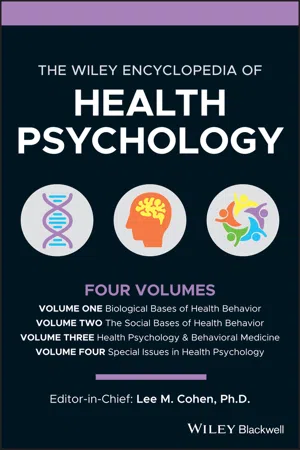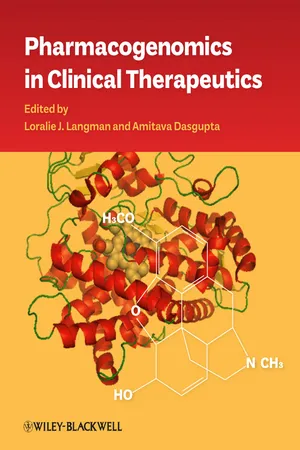Psychology
Genetic Research on Serotonin
Genetic research on serotonin focuses on understanding how variations in genes related to serotonin production and regulation may influence behavior, mood, and mental health. By studying these genetic factors, researchers aim to uncover potential links between serotonin and conditions such as depression, anxiety, and other mood disorders. This research has the potential to inform personalized treatment approaches and interventions for individuals with these conditions.
Written by Perlego with AI-assistance
Related key terms
7 Key excerpts on "Genetic Research on Serotonin"
- eBook - ePub
- Constance Hammen, Ed Watkins(Authors)
- 2018(Publication Date)
- Routledge(Publisher)
As noted earlier, there is no expectation that a particular gene is ‘the’ depression gene that causes depression as a disease state (e.g., Kendler, 2005). Instead, it is apparent that countless genes of very small effects contribute to the vulnerability to depression. Such genes likely affect neural and neuroendocrine mechanisms that determine how individuals dysfunctionally interpret, respond to and cope with life stressors that eventuate in depressive reactions, or that confer particular traits and behavioural tendencies that contribute to depression (a few examples might be insecure attachment, negative cognitive style, neuroticism, ruminative response style, dysfunctional conflict resolution tendencies). In short, virtually every facet of personality and stress reactivity is likely to have heritable components – but how they work together to produce depression is likely very complex indeed. Obviously, genetically regulated processes are strongly modified by environmental, prenatal and childhood experiences and their impact on neural/biological and social development (see discussion in Relationships Between Genes and Environments).Candidate gene studies
Candidate gene studies focus on genes with known function plausibly related to mechanisms of depression. Neurotransmitter systems, especially the monoamines such as those linked to pharmacologic treatment of depression, or hypothalamic–pituitary–adrenal axis and stress reactivity systems, have been implicated in depression, and their genetic characteristics have recently been the focus of research. There has been a large volume of research on candidate genes such as the monoamine oxidase type A (MAOA), the serotonin transporter (5HTT) and its serotonin-transporter-linked polymorphic region, 5-HTTLPR. Serotonin receptor genes, and tryptophan hydroxylase (TPH) genes have been investigated, as well as those controlling dopamine receptors and dopamine transport; all have generally yielded inconsistent or weak findings when cases and controls are compared (Cohen-Woods, Craig and McGuffin, 2013). Interest in genes that regulate responses to stressors has also driven research in recent years, largely to identify new targets for drug development in light of the known association of depression with stressful life event precipitants. Similarly, chronic stress has been found to reduce brain-derived neurotrophic factor (BDNF) gene expression in hippocampal neurons, but Cohen-Woods et al. (2013) have reported few consistent findings of these stress-related gene differences in studies of depression.As we explore in the next section, a consistent and continuing criticism of many studies of genetic differences between depressed and nondepressed samples is their failure to consider that the effects of genes may be modified by environmental exposures and current conditions. Efforts to address such issues are explored next. - eBook - ePub
Stress: Physiology, Biochemistry, and Pathology
Handbook of Stress Series, Volume 3
- George Fink, George Fink(Authors)
- 2019(Publication Date)
- Academic Press(Publisher)
The serotonin transporter in depression: meta-analysis of in vivo and post mortem findings and implications for understanding and treating depression .J Affect Disord. 2015;186:358–366.34. Spies M, Knudsen G.M, Lanzenberger R, Kasper S. The serotonin transporter in psychiatric disorders: insights from PET imaging .Lancet Psychiatry. 2015;2(8):743–755.35. Wellman C.L, Camp M, Jones V.M, et al. Convergent effects of mouse Pet-1 deletion and human PET-1 variation on amygdala fear and threat processing .Exp Neurol. 2013;250:260–269.36. Hariri A.R, Holmes A. Genetics of emotional regulation: the role of the serotonin transporter in neural function .Trends Cogn Sci. 2006;10(4):182–191.37. Canli T, Lesch K.P. Long story short: the serotonin transporter in emotion regulation and social cognition .Nat Neurosci. 2007;10(9):1103–1109.38. Caspi A, Hariri A.R, Holmes A, Uher R, Moffitt T.E. Genetic sensitivity to the environment: the case of the serotonin transporter gene and its implications for studying complex diseases and traits .Am J Psychiatry. 2010;167(5):509–527.39. Caspi A, Sugden K, Moffitt T.E, et al. Influence of life stress on depression: moderation by a polymorphism in the 5-HTT gene .Science - eBook - ePub
Compendium Of In Vivo Monitoring In Real-time Molecular Neuroscience - Volume 1: Fundamentals And Applications
Volume 1: Fundamentals and Applications
- George S Wilson, Adrian C Michael(Authors)
- 2014(Publication Date)
- WSPC(Publisher)
CHAPTER 12 PROBING SEROTONIN NEUROTRANSMISSION: IMPLICATIONS FOR NEUROPSYCHIATRIC DISORDERS Kevin M. Wood, David Cepeda and Parastoo Hashemi Wayne State University 12.1 INTRODUCTIONSerotonin is a unique neurotransmitter. About 98% of the body’s serotonin is located outside of the brain (Cooper et al., 2003), however, as a neuromodulator it plays important, expansive roles. Serotonin is thought to control many essential processes including appetite, sleep, mood, memory, cognition, movement and reward. Imbalances in the serotonergic system are associated with many neuropsychiatric disorders.Autism (Chugani et al., 1997; Sutcliffe et al., 2005), post-traumatic stress disorder (PTSD) (Lee et al., 2005), anxiety (Lesch et al., 1996; Sen et al., 2004; Ramboz et al., 1998), schizophrenia (Inayama et al., 1996; Laruelle et al., 1993), bipolar disorder (Furlong et al., 1998; Young et al., 1994), and addiction (Muller et al. 2007; Sellers et al., 1992) all display distinct deregulations of the serotonergic system.The most notorious of serotonin’s associations, however, is depression. Depression debilitates millions of Americans every year; it is a mental illness that can destroy feelings of joy gained from previous exciting activities. Fatigue, hopelessness, irritability, and excessive sadness can plague the sufferer. In 2011, antidepressants and antipsychotics dominated the pharmaceutical market (Lindsley, 2012).Modern antidepressants typically exaggerate serotonin’s effects in the synapse by slowing down its reuptake. Despite their mainstream usage, antidepressants generate controversy because of variable clinical efficacy (Smith et al., 2002; Cipriani et al., 2009) and systemic side effects (Ferguson, 2001; Masand and Gupta, 2002). Moreover, it is common for patients to take antidepressants for 3–4 weeks without experiencing therapeutic benefit (Gelenberg and Chesen, 2000; Onder and Tural, 2003). During this period patients can experience heightened depression and suicidal tendencies (Stone et al., 2009). - eBook - ePub
The Limits and Lies of Human Genetic Research
Dangers For Social Policy
- Jonathan Michael Kaplan(Author)
- 2013(Publication Date)
- Routledge(Publisher)
As drug-based treatments become ever more sophisticated, the claim that their success shows that it was the brain chemistry all along that was at fault becomes ever more believable. With this conviction that biochemistry is both the culprit and the place at which to generate cures comes a decreasing sophistication in dealing with other potential sources of the alleviation of the psychological pain associated with mood-affective disorders, as drugs become the first-line treatment and, at least partially because they are the first thing tried, the treatment with the highest success rate. The story that is told surrounding depression, then, becomes one of genes, brain chemistry, and the clever pharmacologists whose drugs can alleviate those biochemical problems the unfortunate person’s genotype has left him with.The emphasis on the genes as the ultimate source for behavior hides those environmental factors that are significant. Even where a genetic influence exists, the pathway by which it works remains, for the most part, unexplored. As above, different pathways can have very different implications for the sort of story that is to be told around an illness—it can be the difference between making an affective disorder out to be primarily a mismatch of social order and temperament, or to be a matter of raw biochemical disease.Again, a slightly different story involving a mismatch between temperaments and social environments would have very different implications for explaining, if not necessarily for treating, depression. Indeed, such a story would permit the easy explanation of the rise in rates of depression in developed nations, something a straightforwardly genetic etiology has some trouble explaining (noted by Plomin et al. 1997, 178, and Hamer and Copeland 1998, 85). Of course there isn’t really any very good evidence one way or the other now—both the “direct” model and the “socially mediated” model of the relationship of temperament to depression can account for much of the data available (much of which is pretty questionable anyway—see Piatt and Bach 1997; Bailey 1997; and chapter 3 - eBook - ePub
- (Author)
- 2020(Publication Date)
- Wiley-Blackwell(Publisher)
2016 ). Collectively, these data suggest that unlike the antidepressant effects of increasing synaptic serotonin by blocking the 5‐HTT in adults, elevations of serotonin during prenatal development, and potentially into childhood, may increase risk for depression during adolescence and/or adulthood. Taken together, these findings suggest that the 5‐HTTLPR short allele, which is associated with reduced 5‐HTT efficiency and greater synaptic 5‐HT levels, may increase risk for depression through exposure to elevated serotonin throughout development.5‐HTTLPR: Potential Neural Mechanisms UnderlyingAssociations with Stress‐Related Depression
Amygdala and Neuroticism
Imaging genetics is a research strategy that examines associations between both genetic and epigenetic variation and variability in brain structure, function, and connectivity, as well as risk for psychopathology (Bogdan et al., 2017 ). Imaging genetics provide a unique approach to mechanistically relate differences in 5‐HTTLPR genotype to neural systems that mediate cognition, emotion, and behavior in health and disease (Hariri & Holmes, 2006 ). Most commonly, 5‐HTTLPR imaging genetic studies have investigated amygdala responsivity to threatening information. Broadly, the amygdala and its connections are necessary for recognizing possible threat in the environment and then generating and regulating physiologic and behavioral reactions. Elevated amygdala response to threat is a hallmark of various forms of psychopathology and in particular stress‐related disorder (Bogdan, Pagliaccio, Baranger, & Hariri, 2016 ). Amygdala function is regulated by serotonin (Holmes & Hariri, 2003 ), and Hariri and colleagues (Hariri et al., 2002 ) linked the short allele to elevated amygdala reactivity in one of the first imaging genetic studies. This finding has not been consistently replicated across studies, with meta‐analyses concluding that a small effect may be present (Munafo, Brown, & Hariri, 2008 ; Murphy et al., 2013 but see also Bastiaansen et al., 2014 ). As such, heightened amygdala reactivity associated with the short allele remains a plausible mechanism, among many (e.g., hypothalamic–pituitary–adrenal axis function; Gotlib, Joormann, Minor, &Hallmayer, 2008 ) through which the 5‐HTTLPR polymorphism may confer vulnerability to the depressogenic effects of stress. Indeed, recent evidence that elevated amygdala reactivity prospectively predicts elevated depression symptoms following stressful life event exposure provides support for this speculation (Swartz, Knodt, Radtke, & Hariri, 2015 ). A related interpretation is that given the links between amygdala reactivity and neuroticism (Cunningham, Arbuckle, Jahn, Mowrer, & Abduljalil, 2010 ), it is plausible that elevated amygdala reactivity among short allele carriers contributes to neuroticism, which itself moderates the impact of stressful life events on the development of depression (Kendler, Kuhn, & Prescott, 2004 ). Future adequately powered prospective longitudinal studies employing structural equation models alongside convergent nonhuman animal models are needed to evaluate these putative mechanisms (Bogdan et al., 2016 - eBook - ePub
- Thomas Joiner(Author)
- 2007(Publication Date)
- Harvard University Press(Publisher)
The twin and adoption studies converge to show that genes are involved in suicidal behavior. To return to the issue of the serotonin system, suicide’s “shoeing horn,” we are now honing in on specific genes that may confer risk for suicidal behavior. One gene that has received much attention is the serotonin transporter gene. As noted earlier, the neurochemical serotonin is important in mood, sleep, and appetite. The serotonin transporter maintains control over the availability of serotonin in the synapse, essentially by acting as its recycler—the transporter recycles serotonin back up into the neuron after serotonin is released into the synapse. SSRI drugs used to treat depression like Prozac, Zoloft, and Paxil exert their effects by shutting down or inhibiting the action of the transporter, one effect of which is to leave more serotonin “in play” in the synapse.A single gene is responsible for encoding, or for the “architectural plans,” of the transporter—the serotonin transporter gene. In humans, this gene is located on chromosome 17. A region of this gene has been identified as having what is called a “polymorphism” in it. A polymorphism just means that something can take multiple forms. In the case of the serotonin transporter gene, there are two possible forms, depending on the presence or absence of an additional string of gene building blocks in the gene sequence. Each of the two variations is referred to as an allele of that gene. If an allele has the insertion, it is called a long allele; if it does not, it is a short allele.6 Since all humans carry two copies of each gene, there are three possible combinations of the two alleles: two long alleles (l/l ), a long allele and a short allele (l/s ), or two short alleles (s/s ).There is some emerging consensus that those with the s/s genotype have more dysregulated serotonin systems and thus are more prone to attendant problems. A recent study that followed 103 suicide attempters over the course of a year found that the s/s genotype was more common in people with higher numbers of suicide attempts.7 A postmortem study found that the s/s genotype was more common among suicide victims than among others, although this difference did not reach statistical significance.8 My colleagues and I reported that those with a significant family history of suicide were more likely to have the s/s genotype than were those without a family history.9 - eBook - ePub
- Loralie J. Langman, Amitava Dasgupta(Authors)
- 2012(Publication Date)
- Wiley-Blackwell(Publisher)
15 (young child) synapses. Further complexity is achieved by the use of more than 100 different neurotransmitters, many of which interact with several different receptors with multiple anatomic locations and signaling pathways. In contrast with this complexity, a relatively small number of targets have been explored for therapy of mental illness, most commonly involving the serotonin-, dopamine-, norepinephrine-, or gamma-aminobutyric acid (GABA)-dependent pathways. While remarkable effectiveness has been achieved in several conditions, such as in schizophrenia or major depression, allowing a large number of affected individuals to lead nearly normal lives, there is wide variability in the effectiveness and tolerability of most psychotropic drugs. Given the complexity of brain biochemistry and signaling pathways, it is not surprising that broad-spectrum pharmacological interventions (e.g., generalized inhibition of serotonin reuptake at the synapses) are not universally effective and often have undesirable effects. Newer generation psychotropic drugs tend to have narrower targets and more specific actions, with fewer side effects. As an example, newer antidepressants targeting serotonin uptake lack the anticholinergic effects mediated by inhibition of muscarinic acetylcholine receptors in brain and intestine by older tricyclic antidepressants. However, even for newer drugs, predictability of therapeutic effectiveness and tolerability remains difficult. It is likely that reliable, personalized pharmacotherapy of mental disease will require understanding of all the important pathways involved in disease causation and modification, therapeutic and off-target drug effects (pharmacodynamics), and drug pharmacokinetics (absorption, distribution, metabolism, and elimination, or ADME).The discipline of pharmacogenomics is focused on understanding how genetic variation affects pharmacotherapy, while pharmacogenetics (PGx) can be more narrowly defined as the study of variation in specific genes in relation to their effect on drugs. In the case of psychotropic drugs, the number of pharmacogenetic studies has been exponentially growing, even though it is certain that given the complexity of brain biochemistry, pathology, and pharmacology, current knowledge is only beginning to evolve and no definite recommendations for the use of PGx testing to guide therapy can currently be made. This chapter focuses on some examples on the effect of genetic variation on the pharmacodynamics (PD) and pharmacokinetics (PK) of psychotropic drugs.Genetic Versus Environmental Factors in Mental HealthMental illness is undoubtedly influenced by many environmental factors, including parenting, socioeconomic stressors, social networks, infections, climate, nutrition, and so on. An interaction between genetic and environmental factors has been observed in several mental disorders, including schizophrenia (1), major depression (2), bipolar disease (3), panic disorder (4), and attention-deficit/hyperactivity disorder (ADHD) (5). A meta-analysis of twin studies concluded that the genetic susceptibility for schizophrenia averaged 81% (95% confidence interval of 73–90%), while environmental factors accounted for about 11% of the risk (1). In the case of major depression, heritability accounted for 37% (CI = 31–42%) of liability, while individual-specific environmental factors accounted for 63% of the risk (2). The role of environmental factors compared to genetic predisposition is higher for less severe behavioral illnesses, including personality (6), anxiety (7), and addictive (8) disorders.
Learn about this page
Index pages curate the most relevant extracts from our library of academic textbooks. They’ve been created using an in-house natural language model (NLM), each adding context and meaning to key research topics.






